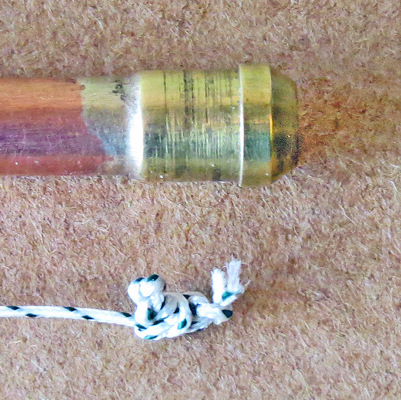| A
common problem that I have encountered is that of trying to get wires
or cables threaded through tubes that have been bent into complex
shapes. No matter how hard you try to push something through the
tube eventually the friction created as the thing you are pushing tries
to go around the corners becomes too great and it becomes impossible to
push the thing any further. Occasionally you can get around the
problem by threading a "puller" through the tube before you bend it and
then using the puller to pull the wires or cables through the finished
tube, but if the tube requires further heating for annealing or
soldering then this solution most likely won't work as the heat will
destroy your "puller". The solution described below has always worked for me without any problems. |
|
 The
first thing you require is a thin, strong, and flexible puller. I
always use braided Dacron fishing line which has a breaking strain of
over 30lbs (15Kg) even though it is less than 0.5mm in diameter.
The photo on the right shows one of the 5/32" diameter copper
tubes that were used on my Feldbahn's headlamp installation, and below
it is the Dacron line with enough knots tied at its end to make it a
loose fit inside the tube. The
first thing you require is a thin, strong, and flexible puller. I
always use braided Dacron fishing line which has a breaking strain of
over 30lbs (15Kg) even though it is less than 0.5mm in diameter.
The photo on the right shows one of the 5/32" diameter copper
tubes that were used on my Feldbahn's headlamp installation, and below
it is the Dacron line with enough knots tied at its end to make it a
loose fit inside the tube.
|
Stage
two requires some bits of plastic pipe that will be a tight push fit
over your tube end and that can be attached to a compressed air line,
or if you don't have a compressed air system available a cold water
tap. The photo below shows an example of how things are setup.
The Dacron line is threaded through the collection of plastic
pipes with the plain end taped to the outside of the plastic pipe at
the compressed air (or water tap) end). The knotted end of the
Dacron line is pushed a little way into the copper tube before the
plastic tube is pushed over the end of the copper tube. Make sure
that there is enough Dacron line inside the plastic pipes to reach all
the way through your copper tube.

Now
use the compressed air, or water, to blow (or wash) the Dacron line
through the copper tube. As the Dacron is so flexible it will
easily work its way around any bends, and the multiple knots at the end
ensure that there is enough resistance for the air (or water) to push
against and thus move the Dacron through the tube. Once the
Dacron is threaded through the copper tube the plastic pipes can be
removed, taking care to keep both ends of the Dacron outside the ends
of the copper tube. |
 Now form a loop in the end of the wire and solder the loop so that it can't come open before tying the Dacron line through the loop. The Dacron line can now be used to pull the wire through the copper tube. Now form a loop in the end of the wire and solder the loop so that it can't come open before tying the Dacron line through the loop. The Dacron line can now be used to pull the wire through the copper tube. |


 The
first thing you require is a thin, strong, and flexible puller. I
always use braided Dacron fishing line which has a breaking strain of
over 30lbs (15Kg) even though it is less than 0.5mm in diameter.
The photo on the right shows one of the 5/32" diameter copper
tubes that were used on my Feldbahn's headlamp installation, and below
it is the Dacron line with enough knots tied at its end to make it a
loose fit inside the tube.
The
first thing you require is a thin, strong, and flexible puller. I
always use braided Dacron fishing line which has a breaking strain of
over 30lbs (15Kg) even though it is less than 0.5mm in diameter.
The photo on the right shows one of the 5/32" diameter copper
tubes that were used on my Feldbahn's headlamp installation, and below
it is the Dacron line with enough knots tied at its end to make it a
loose fit inside the tube. 
 Now form a loop in the end of the wire and solder the loop so that it can't come open before tying the Dacron line through the loop. The Dacron line can now be used to pull the wire through the copper tube.
Now form a loop in the end of the wire and solder the loop so that it can't come open before tying the Dacron line through the loop. The Dacron line can now be used to pull the wire through the copper tube.